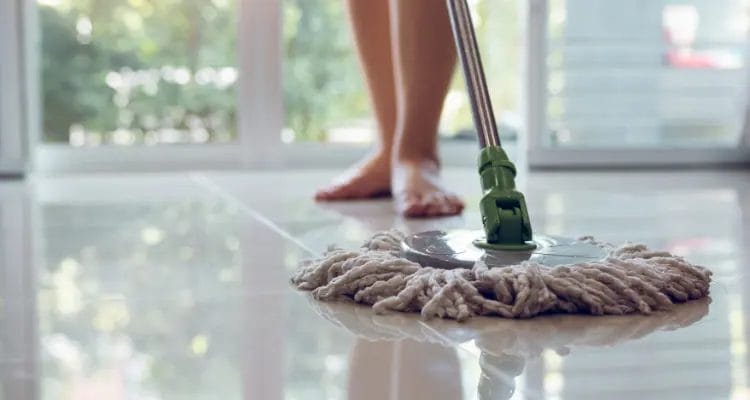Water is one of the most destructive elements that can affect your home. A single flood can cause extensive damage and leave you with a huge cleanup bill. If your home has been hit by water, it is important to take action immediately to minimize the damage. This guide will teach you how to soak up water from a flooded floor using effective methods and materials.
How to Soak Up Water from a Flooded Floor
If your home has been flooded, you will likely need to remove water from your floors. Here are some tips on how to do this quickly and effectively:
1. Start using a mop or towels to absorb as much water as possible.
2. If you have a wet/dry vacuum, you can use this to remove the remaining water from carpeted or hard floors.
3. Another option is to rent a floor extractor to remove water from floors.
4. Once you have removed as much water as possible, open all doors and windows to allow the area to air out completely.
5. You may also need to remove damaged flooring, such as carpet or tile.
Here are some more ways to soak up water

Drying Fan
You can speed up the drying process by using a drying fan, which is just an electric fan. Place the fan in front of or behind the surface but not directly underneath it. If you place it directly under the surface, you’ll blow the water back onto your floor instead of moving it away.
If you’re concerned about mold and mildew growth on your floors after they’ve been dried out with fans (and we know you are), use a dehumidifier to help prevent that problem.
Also, while dryers do their job well and quickly, they tend to make things hot–not good for wood floors or other materials around them.

Mopping
Now that you have your mop and cleaning solution, it’s time to clean up the mess.
Soak up as much water from the floor as possible before starting to mop.
Use warm water rather than cold water for mopping purposes. Warm water is more effective at removing grease, oil, and dirt from your floors, so it’s best not to use cold water if you can avoid it. Warm water also helps prevent damage caused by freezing temperatures when there’s still standing floodwater in your home or office building.
Use a sponge or cotton cloth on top of the mop head when mopping up the excess liquid from your flooded flooring material (e.g., carpet). This will help absorb more liquid in one pass over an area than just the bottom surface of a traditional string-type mop head would allow for, thus speeding up how quickly you can get rid of excess moisture.

Paper Towels
Paper towels are the perfect tool for soaking water from a flooded floor. They’re absorbent, easy to use, and inexpensive. Plus, they’re disposable (saving you from having to do an extra load of laundry), environmentally friendly, and work well on small spills like these. However, a mop might be better suited for the job than paper towels if you have a larger spill or flood in your home, for example, if your dishwasher overflowed.
Washing Machine
If you have a washing machine, put the water-soaked clothes in it and run a full cycle. Make sure to use a detergent that is safe for washing machines. If this is not an option, use a large bucket and wash the clothes by hand.

Newspapers or Magazines
The most common way to soak up water is with newspaper. This is because newspapers are made of paper, which makes them absorbent and great at soaking up water. They’re also biodegradable, so you won’t have to worry about the waste after you throw them away.
Newspapers are cheap, easy to find, and easy to use. In addition, they’re disposable: once you’ve used all the newspapers you need or want, just throw them away.
Soaking up water from a flooded floor is a difficult and time-consuming task. However, it is important to take action immediately to minimize the damage caused by the water. Following these tips, you can remove water from your floors quickly and effectively.
How long does it take for water to go stagnant?
Stagnant water is water that has been sitting still for more than 24 hours. After this time, the water will become stagnant and start supporting the growth of bacteria and other microorganisms.

What are some ways to prevent flooding?
There are several things you can do to help prevent flooding in your home or office:
-Install check valves in sewer lines and drains to prevent backflow.
-Disconnect downspouts and redirect runoff away from foundations.
-Grade landscaping so that it slopes away from buildings.
-Repair leaks in gutters, roofs, and pipes.
-Install a sump pump to remove water from the basement or crawl space.
-Store hazardous materials in proper containers and away from areas that could flood.
Does flooded water cause mold growth?
Yes, mold will begin to grow if the flooding is severe enough and the water is not removed quickly enough. The mold will feed off any organic matter in the water, including the paper on drywall, carpeting, clothing, and anything else it comes into contact with.
If you have had a flood, you need to take quick action to remove all the water and dry out your home or office as soon as possible to prevent mold growth.
Frequently Asked Questions:
What absorbs water the fastest?
How do you dry out a wet floor?
Does baking soda absorb water?
Is sand good for soaking up water?
What should you not use to soak up water?
Conclusions:
Now that you read through all the steps, it is time to take action. First, ensure everything is safe and use proper safety measures while undertaking this job. Then start your work on a flood-affected area by carefully removing the mounds of water to avoid any possible accidents. Once that is over, start moving ahead with vacuuming and mopping up the mud and other debris until there are no more signs of flooding.






